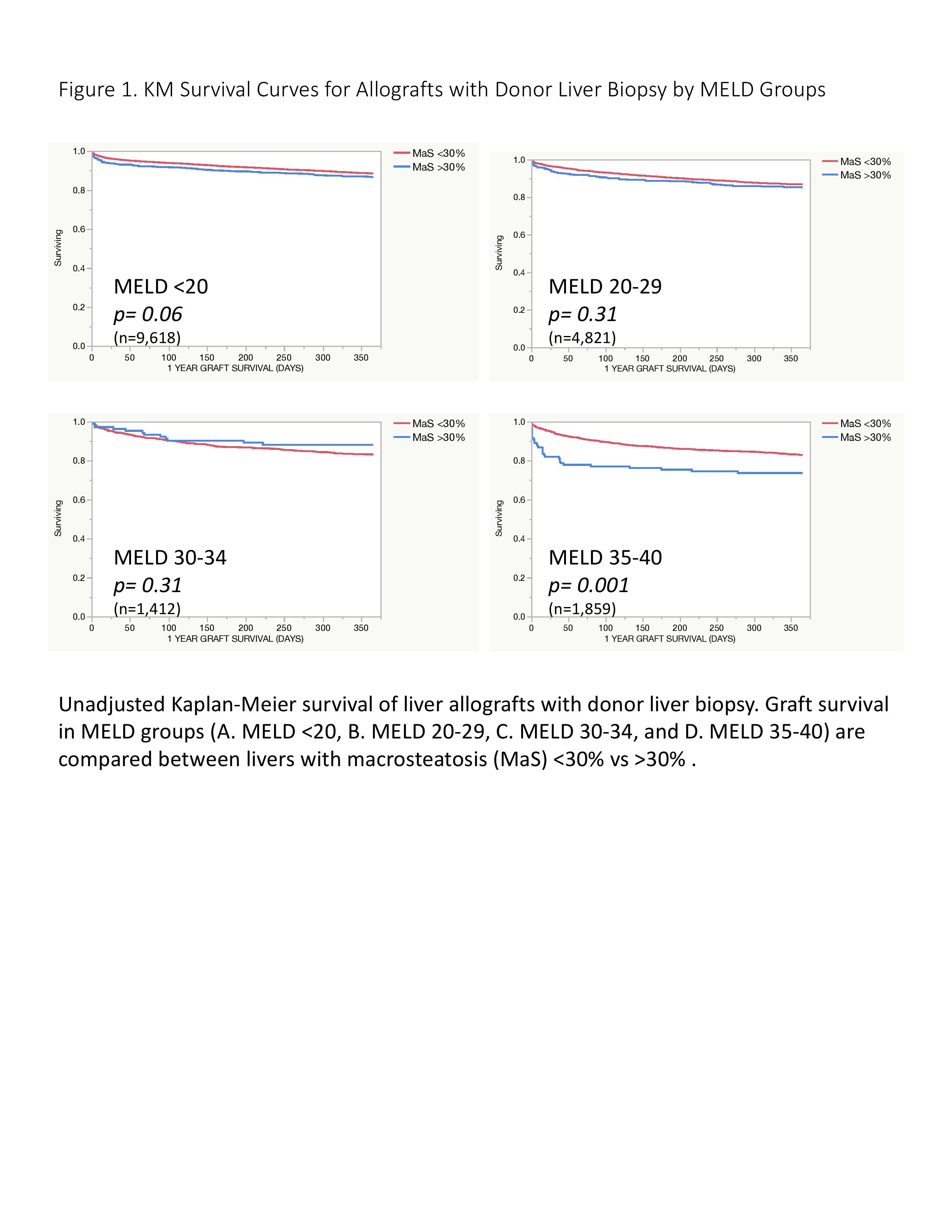Trimming the Fat?: Optimizing Utilization of Liver Allografts with Macrosteatosis >30% in Recipients with MELD Scores <35
1Surgery, Cedars-Sinai Medical Center, Los Angeles, Los Angeles, CA, 2Transplant Surgery, Cedars-Sinai Medical Center, Los Angeles, Los Angeles, CA
Meeting: 2019 American Transplant Congress
Abstract number: A300
Keywords: Biopsy, Donors, marginal, Graft survival, Risk factors
Session Information
Session Name: Poster Session A: Liver: Recipient Selection
Session Type: Poster Session
Date: Saturday, June 1, 2019
Session Time: 5:30pm-7:30pm
 Presentation Time: 5:30pm-7:30pm
Presentation Time: 5:30pm-7:30pm
Location: Hall C & D
*Purpose: Macrosteatosis (MaS) >30% in liver allografts has been associated with increased risk of primary non-function and poor graft survival. This study assesses the influence of donor and recipient characteristics on graft survival in allografts with MaS >30%.
*Methods: Transplants with donor liver biopsy between January 2006 and June 2016 were identified in the UNOS Standard Transplant Analysis and Research database. Donor and recipient characteristics were evaluated. Univariate and multivariable Cox proportional hazards and Kaplan-Meier survival analyses were performed for 1-year graft survival. Hazard ratios (HR) were calculated and p-values <0.01 were considered significant.
*Results: 17,778 liver transplants were identified, of which 1,522 (8.5%) had MaS >30%. Amongst all organs with pre-donation biopsy, MaS >30% carried increased risk of graft loss at 1-year (HR 1.27, 95% CI 1.09-1.47, p=0.002). Other risk factors included older donor age, DCD status, longer cold ischemic time, older recipient age, Black race, higher MELD score, acute liver failure, prior abdominal surgery, dialysis and mechanical ventilation. Recipients were stratified by MELD score. No significant difference in 1-year graft survival was observed between grafts with MaS <30% and MaS >30% for recipients with MELD scores <20, 20-29, and 30-34. However, in recipients with MELD 35-40, MaS >30% carried significantly increased risk of graft loss in multivariate analyses (adjusted HR 1.27, 1.09 – 1.47, p<0.001).
*Conclusions: Donor liver biopsy is a useful tool for evaluation of available livers prior to transplant. Allografts with MaS >30% can be used for recipients with MELD <35 with nearly equivalent outcomes to reduce organ discard rates and reduce the waitlist for liver transplantation.
To cite this abstract in AMA style:
Steggerda JA, Bloom MB, Todo T, Brennan TV, Nissen NN, Klein AS, Kim IK. Trimming the Fat?: Optimizing Utilization of Liver Allografts with Macrosteatosis >30% in Recipients with MELD Scores <35 [abstract]. Am J Transplant. 2019; 19 (suppl 3). https://atcmeetingabstracts.com/abstract/trimming-the-fat-optimizing-utilization-of-liver-allografts-with-macrosteatosis-30-in-recipients-with-meld-scores/. Accessed December 16, 2025.« Back to 2019 American Transplant Congress

